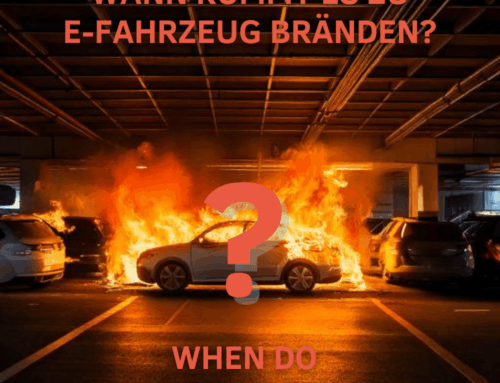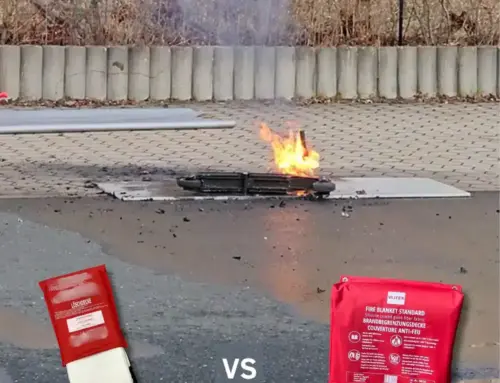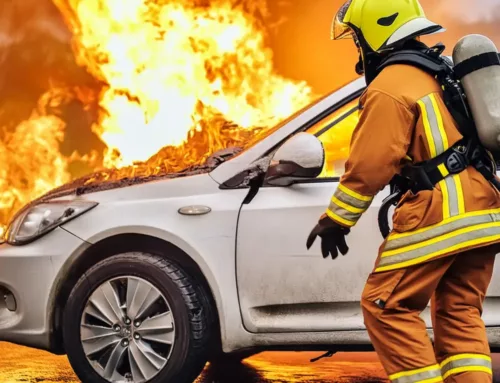
Battery fires pose a particular challenge: Neither the removal of oxygen nor simple extinguishing with water leads to the desired success. Increasingly, Fire blankets made from technical textiles such as glass fiber fabric with a silicone coating are being used. But how effective are these products really? Together with the Saxon Textile Research Institute (STFI), we tested Fire blankets from VLITEX and two competitors. The results show clear differences in temperature resistance and reusability.
Table of contents
What is a fire blanket? (definition)
A fire blanket is a special Fire blanket made of fire-resistant materials that has been developed for battery fires. It is used to protect the surrounding area from heat, smoke and flames by covering the burning object and containing the fire. Unlike conventional vehicle fires, battery fires cannot simply be extinguished, as the oxygen required for the fire is contained in the battery itself.
Why are battery fires so difficult to fight? (Background information)
Thermal runaway - the self-reinforcing fire process
A lithium-ion battery consists of many cells. If one cell catches fire, the heat is transferred to neighboring cells, leading to a chain reaction known as thermal runaway. This process can only be stopped if the temperature of the battery is lowered below 70 °C. However, this is difficult as batteries are often installed deep in the vehicle.
Water as a coolant
Although water can be used to cool the battery in order to interrupt the chain reaction, enormous quantities are required. For example: Tesla recommends up to 12,000 liters of water to completely extinguish a vehicle fire.
Environmental impact
In addition to heat and smoke, battery fires also release harmful chemicals that pollute the environment. Preventive measures such as fire blankets are therefore particularly important to prevent the fire from spreading.
Comparative test: How the Fire blankets were tested
Test conditions
The STFI tested tissue samples from three products:
- VLITEX fire blanket E-AUTO
- Leader Stop Fire blanket
- Ace Blanket from Acetec
The samples were heated at 750 °C for 15 and 30 minutes - temperatures that frequently occur during battery fires. The samples were then tested for their structure and flexibility.
Results in detail
- Acetec "Ace Blanket"
- Breaks during the buckling test after heat treatment.
- Loses almost the entire coating and shows no residual strength.
- Conclusion: Not suitable for battery fires.
- Leader Stop Fire blanket
- Similar results to the Acetec blanket: brittle and not flexible after heat treatment.
- Conclusion: Also not suitable for fighting battery fires.
- VLITEX fire blanket E-AUTO
- Remains stable and flexible after heat treatment.
- The coating shows slight wear, but the fabric retains its strength and can be used several times.
- Conclusion: The only product tested that is suitable for battery fires.
How does a fire blanket work in use?
fire blankets such as the VLITEX E-AUTO are placed over the burning vehicle by firefighters. They prevent the spread of flames and smoke and protect the surrounding area from heat. While conventionally burning parts are extinguished due to the lack of oxygen, the battery under the blanket continues to burn in a controlled manner. This gives emergency crews the time they need to safely monitor the fire and prevent secondary fires.
Alternative methods for fighting battery fires
In addition to Fire blankets , there are other approaches, some of which have considerable disadvantages:
- Water tanks: Vehicles are completely immersed in water. This requires a great deal of effort and inevitably leads to total damage. In addition, hundreds of liters of contaminated water have to be disposed of.
- Extinguishing lances: A lance is driven into the battery to inject water directly. However, this method is difficult to use as batteries are often difficult to access.
- Water bags: The vehicle is lifted into a water-filled plastic cover. Here, too, the effort and costs are considerable, and the system can only be used once.
The best solution for battery fires
The comparative test shows that not all Fire blankets are suitable for the special requirements of battery fires. While the products from Acetec and Leader lose their structure at 750 °C and become brittle, the VLITEX fire blanket E-AUTO remains stable and flexible. It is therefore the only tested blanket that is actually suitable for fighting battery fires.
Advantages of the VLITEX E-AUTO
- Temperature resistant up to 1,000 ° / briefly up to 1,750°C.
- Reusable, depending on the fire load.
- Flexible and easy to handle, even after heat treatment.
- DIN SPEC 91489 certified.
With its reliable performance, the VLITEX E-AUTO offers an effective and economical solution for emergency services faced with the challenges of battery fires.









